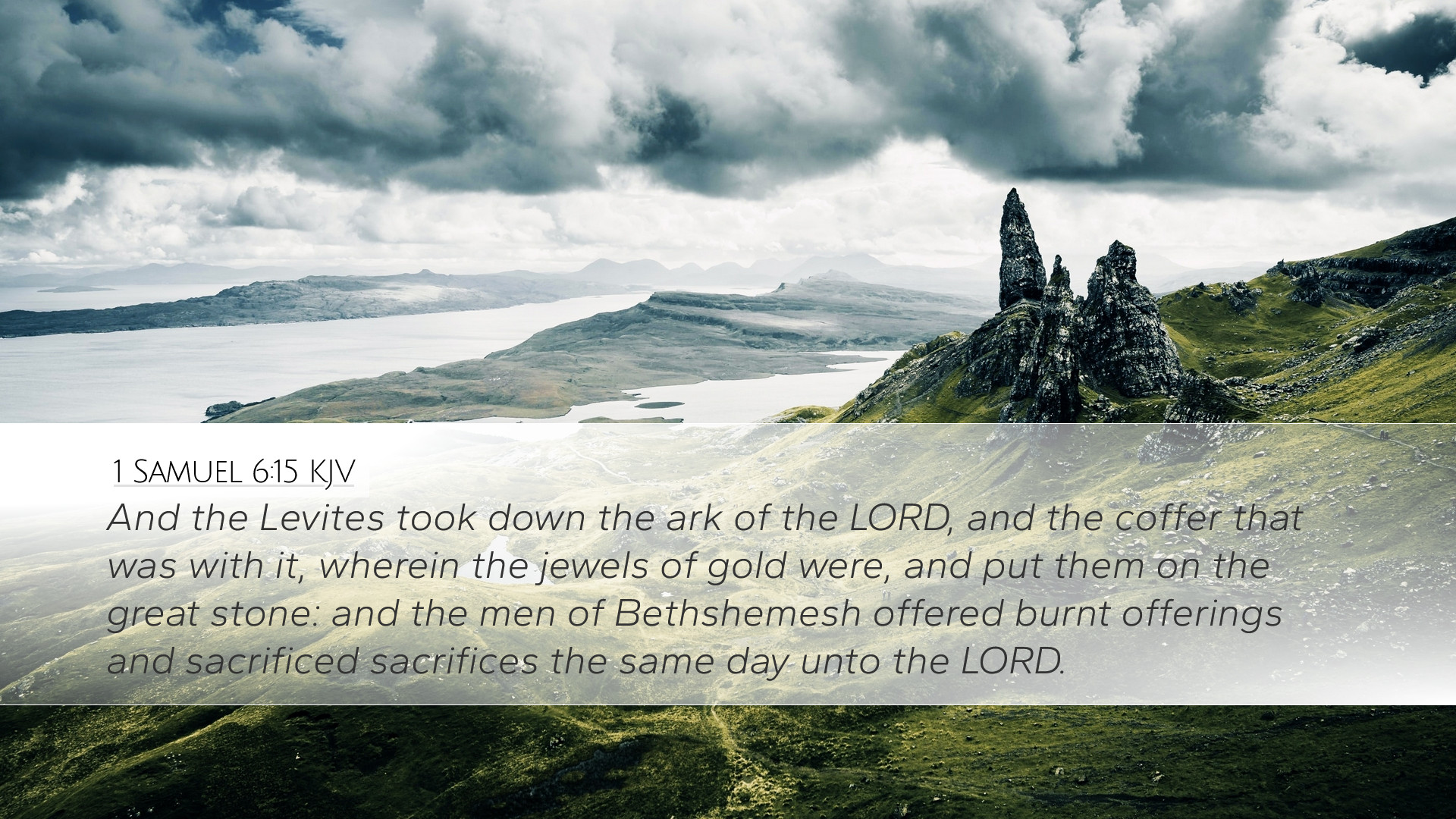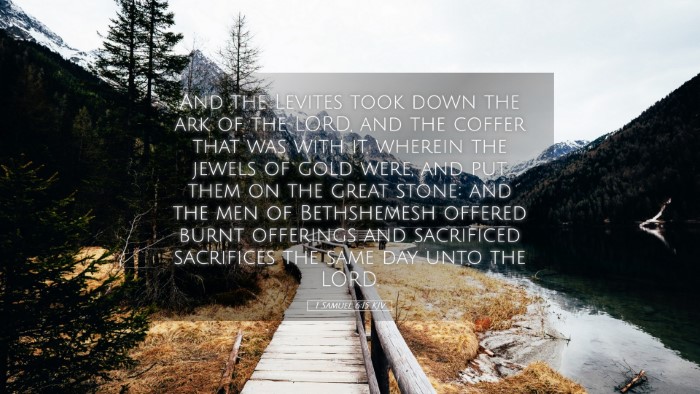Commentary on 1 Samuel 6:15
Bible Verse: "And the Levites took down the ark of the Lord, and the coffer that was with it, wherein the jewels of gold were, and put them on the great stone: and the men of Bethshemesh offered burnt offerings and sacrificed sacrifices the same day unto the Lord."
Introduction
The passage of 1 Samuel 6:15 marks a significant moment in the biblical narrative, where the Ark of the Covenant returns to Israel after its capture by the Philistines. This verse highlights the transition from the capture and loss of the Ark to its restoration and the reverent response of the Israelites. The commentaries from various public domain sources provide insights into the theological implications, historical context, and practical applications of this event.
Thematic Overview
- Restoration of the Ark: The Ark's return symbolizes God's mercy and restoration of His presence among His people.
- Reverence and Worship: The actions of the Levites and the men of Bethshemesh reflect a proper response to the sacredness of God’s presence.
- Sacrifice and Offering: The offerings made signify acknowledgment of God's sovereignty and divine favor.
Exegesis and Analysis
Levites' Role: The Levites' involvement in the handling of the Ark is significant, as they were ordained for service in the sanctuary and tasked with the care of sacred objects. According to Matthew Henry, their careful handling implies the holiness of the Ark and the serious nature of its return.
Context of the Ark's Capture: The previous chapters recount how the Philistines captured the Ark, leading to judgments upon them, which ultimately compelled them to return it (refer to 1 Samuel 5 and 6). Albert Barnes notes that the Ark was not merely a trophy of war, but a representation of God's covenant with Israel. Its return was an act of divine restoration.
The Act of Offering
The burnt offerings and sacrifices made by the men of Bethshemesh exhibit an understanding of the sacrificial system ordained by God. Adam Clarke elaborates on the significance of burnt offerings as acts of complete dedication to God, illustrating the heartfelt gratitude of the people for the restoration of God's presence through the Ark. Clarke emphasizes that their sacrifices were not mere ritual acts but genuine expressions of worship.
Understanding the Offerings
- Burt Offerings: Symbolize total surrender to God and atonement.
- Peace Offerings: Indicate fellowship with God, suggesting joy and gratefulness upon the Ark’s return.
The Great Stone
The Ark and the coffer containing the golden trespass offerings were placed on a great stone. This imagery has rich symbolical meaning. Matthew Henry interprets the stone as a symbol of strength and permanence, suggesting that God’s presence among His people is a firm foundation in times of calamity and distress.
The Response of the People
The men of Bethshemesh represent a community's response to the miraculous return of the Ark. They recognized the gravity of the event, marked by worship and sacrifices. Albert Barnes emphasizes that this response serves as a model for communities today, showcasing the importance of coming together in worship, especially after experiencing God’s deliverance and grace.
Theological Implications
1 Samuel 6:15 reflects key theological themes in biblical narrative:
- The Presence of God: The Ark symbolizes the divine presence, which is crucial to the identity of Israel as God’s chosen people.
- Worship in Spirit and Truth: The actions of the Levites and the men demonstrate that true worship necessitates a heart that acknowledges God's holiness.
- God’s Sovereignty: The return of the Ark showcases God’s ultimate control over the events in history and His faithful covenant with Israel.
Application for Today
For pastors, students, theologians, and scholars, this passage encourages reflection on the nature of worship and the importance of recognizing God's presence in the community. Adam Clarke points out that the act of sacrifice today may not look the same, but it calls for a lifestyle of dedication and gratitude toward God for His continuous presence in our lives.
Moreover, communal worship similar to that displayed by the men of Bethshemesh fosters unity and reinforces the church's identity as the body of Christ, called to celebrate and acknowledge God's faithfulness.
Conclusion
The events of 1 Samuel 6:15 serve as a profound reminder of reverence, worship, and thanksgiving in the presence of God. The sacredness of taking care of God’s promises, illustrated through the Levites, and the collective response from the people exemplifies the ideal relationship believers are called to maintain with God. By studying these insights, church leaders and believers alike can better grasp the significance of worship, sacrifice, and community in honoring God's enduring presence.


